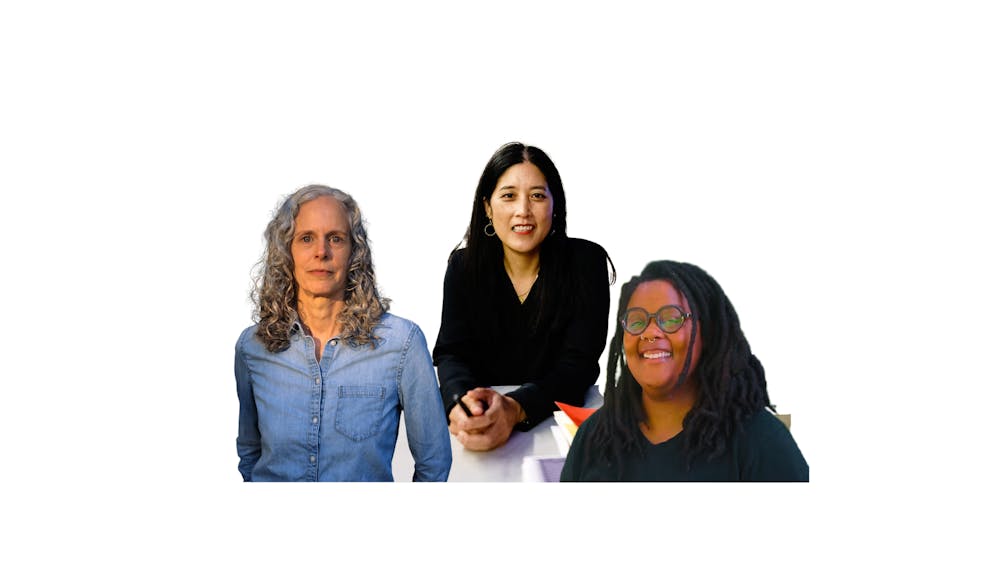
Not quite a dance show, not quite a play. It's seemed that no one really knew what to say about "Free/Fall," the latest effort from Emory's Department of Theater and Dance. That's part of what made the show so ambiguous, and also part of what made it so special.
The result of a longtime desire to stage a joint production featuring both the Emory Dance Program and Theater Emory, "Free/Fall" involved theater faculty, dance faculty, theater students, dance students, local performers and astronomers. Yes, astronomers.
The performance opened last Thursday at the Mary Gray Munroe (MGM) Theater in the Dobbs University Center and runs through next Sunday.
You probably remember a couple years ago when skydiver and professional daredevil Felix Baumgartner jumped from 24 miles above the earth's surface, becoming the first human to break the sound barrier under his own power. Baumgartner was famously quoted as saying, "Sometimes you have to go up really high to understand how small you really are."
But still, free-falling for 24 miles – how could he ever work up the nerve to just jump?
That phenomenon was the impetus for "Free/Fall" – a part-theater, part-dance show which explored concepts of gravity, infinity, life, death and our place in the cosmos.
The MGM Theater had been transformed for the performance from its regular orientation as a traditional proscenium venue to a theater in the round: audience members sat on all sides of the stage.
The seats were elevated above the ground, allowing for a wall of planetary images below each group of seats. The walls featured astrological signs, actual light-up stars and drawings of the solar system's measurements.
As the show began, the 13 performers walked almost trance-like up to the audience, then continued walking onto the stage, where they faced straight ahead silently. Then with a big bang!, they collapsed onto the floor, and spent the rest of the performance gradually extending themselves from that fallout, much in the way the solar system itself has been expanding since the Big Bang.
In some moments, they were moving. In some, they were conversing. But they were always, always searching.
The monologues the performers gave tended to concern how science, physics and the cosmos affect our individual lives. With the insane vastness of the universe out there, it can be hard to wrap your head around its magnitude, and this was a question that the entities of "Free/Fall" struggled with.
For instance, "Free/Fall" explains, we're all stardust. Literally, we are composed of remnants of dead stars: life forms which lived for far longer than any of us will.
"Maybe the person I'm supposed to be with isn't even made yet," one performer lamented after giving that explanation. "Maybe she's out in a nebula bed somewhere."
Other times, they would latch onto a particular phrase and repeat it in different ways, with different intonations and accompanying movements, to drive home that theme.
At one point, they repeated, "Take a risk," for several minutes.
And one performer stepped up to the top of one of the walls, where he stood still, arms extended outward and taking deep breath after deep breath, as if working up the nerve to jump.
And in what I found to be the most emotional, tense and heartbreaking moment of the entire 75-minute production, he didn't jump. Instead, he let his arms down, took one final breath, and carefully hopped down. Moments like these were what gave "Free/Fall" its humanity: sure, the idea of infinity and risk-taking and exploring the great unknown is beautiful and romantic, but sometimes it's just not how humans operate.
At its core, "Free/Fall" had a lot of science to thank for its content. Performers related masses of astronomical information to the audience – sometimes excessive amounts – but this information was vital to grasping the central theme of just how difficult the cosmos are to understand.
The movement of "Free/Fall" was just as vital to its overall tone as the dialogue. The performers supported, pushed, fought and assisted one another.
When they moved on their own, they crawled, rolled, spun and ran. It ultimately felt childlike in its plainness; the players all came off as innocent and naïve in the way they approached the topics of "Free/Fall."
Not to say that they came off as dumb or juvenile. They just seemed to be saying that when it comes to the questions of infinity, no one has the answers.
Ultimately, if anyone knows anything about falling, it's Baumgartner. And as College junior Kelly Spicer pointed out during her monologue, "Even he was terrified. He fell in a violent spin; he was about to pass out."
Falling is scary. Gravity is scary. But as "Free/Fall" reminded the audience, there is no up.
Our up is relative to where we are on the earth, in the solar system, in the universe – it's always changing. So scary as it may be, we're always falling.
– By Emelia Fredlick





